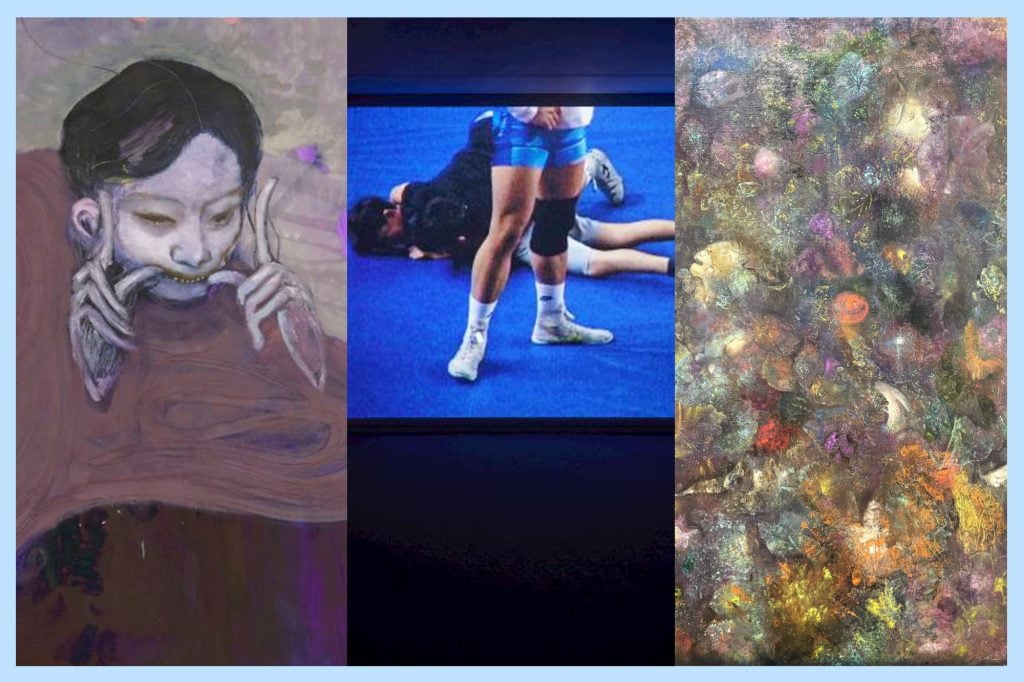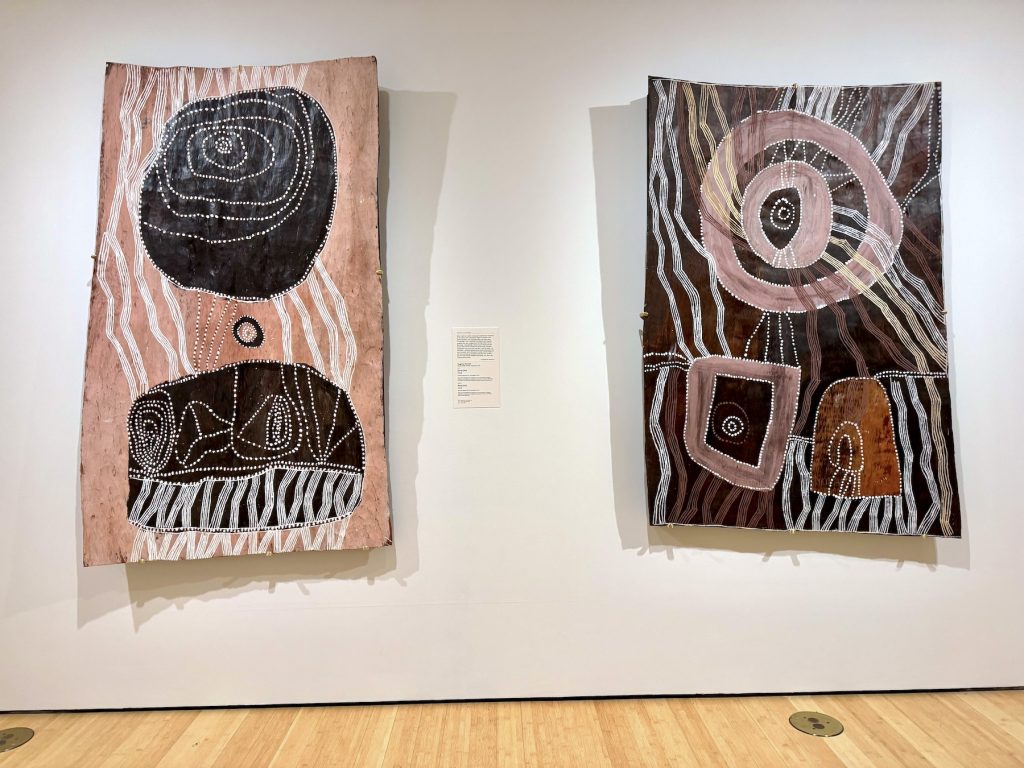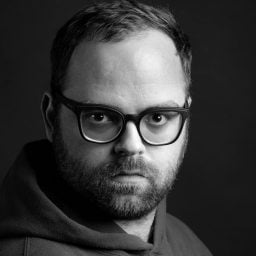Art & Exhibitions
The Best Art of 2024: 11 Standouts We Saw Globally
From blockbuster shows to hidden gems, here's what caught our eye.

As 2024 comes to a close, the Artnet News team has taken a moment to reflect on the year in art. From gallery shows and museum exhibitions to biennials and art fairs, we’ve seen it all.
Amid the whirlwind of creativity, some works stood out—whether for their extraordinary craftsmanship, profound meaning, or undeniable artistic virtuosity. Here’s what captured our attention—and our hearts—in 2024.
Leonor Fini, 14 cats in a forest (1962) at Centre Pompidou, Paris

Leonor Fini’s 14 cats in a forest on view at Centre Pompidou’s Surrealism exhibition. Photo by Margaret Carrigan.
I am a childless cat lady and gladly so. Imagine my delight, then, when I came across 14 cats in a forest by fellow offspring-free feline enthusiast Leonor Fini at Centre Pompidou’s phenomenal Surrealism show.
I knew the Italian-Argentine surrealist had at one point kept 23 cats while she was living in Paris and palling around with Leonora Carrington and Max Ernst. Fur has even been found trapped in the paint on some of her canvases (any cat owner can sympathize). Yet this 1962 painting was a departure from the moody, affronting, erotically-tinged portraits of women for which I know Fini best. Instead, soft, impressionistic cat faces appeared like nebulae amid a cosmic-like expanse of riotous color exploding across the canvas. It was like a game trying to find all 14 in the chaos, a game I ended up losing.
I liked the painting well enough for the cat content but what made me love it was its sense of play—not only implied by the fact that Fini seemed to be having a laugh by painting some of her cats, but also in its invitation to the viewer to simply enjoy the act of looking. As someone who sees a lot of art, it’s amazing how often I forget to do that.
—Margaret Carrigan
“Andrea Chung: Between Too Late and Too Early” at the Museum of Contemporary Art North Miami

Andrea Chung, Sea Change (2017). Photo courtesy of the artist and Tyler Park Presents Gallery.
Miami Art Week is both the best and worst way to end each year, a mad dash to see as much art (and go to as many parties—and hopefully the beach) as you can during a market-fueled, increasingly corporate-sponsored circus. But my first-ever trip to the Museum of Contemporary Art North Miami, to see Andrea Chung’s revelatory survey show “Between Too Late and Too Early,” was a reminder that the week can be an opportunity to see some truly amazing work by artists from around the world.
I was stopped in my tracks by the show’s opening gallery, where four walls are covered with a site-specific, monumental mural made from cyanotypes on watercolor paper. I have always loved this early form of photography, but here its beauty serves as a soft landing as you dive into Chung’s challenging themes of the history of colonialism and slavery in the Caribbean, as well as the present-day threat of climate change.
In both an apt metaphor for this ugly past as well as a warning for the future, the watery scene depicted in the work, titled Sea Change, is full of invasive lionfish that are devastating the region’s natural habitat. The wall text for another body of work references the first book of photography ever printed, of cyanotypes—but points out that the artist, Anna Atkins, was able to finance the project because her father-in-law and husbands owned plantations in Jamaica.
The show makes clear that Chung is a master of balancing beauty and pain, sorrow and hope. A sculpture of a circle of life-size hands, also in cobalt blue, seems to reach out from under the waves, suggesting drowning bodies. But the 2022 work, “If they put an iron circle around your neck I will bite it away” isn’t just referencing the kidnapped Africans thrown overboard during the Middle Passage. It is also about the modern Afrofuturist myth of Drexciya, where those who died on the journey actually forged their own underwater civilization—a theme that was also at the heart of my pick for best work in 2023.
—Sarah Cascone
Haegue Yang, Star-Crossed Rendezvous after Yun (2024), at Hayward Gallery, London

Installation view of Star-Crossed Rendezvous after Yun (2024) at “Haegue Yang: Leap Year.” Photo by Mark Blower, courtesy the artist and the Hayward Gallery.
In his atrocious review of Haegue Yang’s survey show “Leap Year,” the Guardian‘s critic Jonathan Jones complained that the South Korean artist’s art does not “express human pain or longing.” Reading his jarring comments after seeing the artist’s first U.K. survey show at London’s Hayward Gallery, I questioned my own senses for a moment. Was I hallucinating when I felt overwhelming pain and longing sitting in front of the colossal venetian blinds installation Star-Crossed Rendezvous after Yun, the new commission featured at the exhibition? As I watched shadows cast by the blinds moving hypnotically, illuminated by two spotlights on both sides dancing but out-of-sync to a haunting classical score, my skin prickled with goosebumps, my heart felt heavy. I had the urge to rush over to read the wall text and Google who “Yun” was.
Only later did I learn that Yun refers to the Korean-born composer and political dissident Isang Yun, and the piece of classical music was his 1977 work Double Concerto, inspired by a Korean folktale about two star-crossed lovers condemned to eternal separation, reunited only once a year across the galaxy. The themes of excruciating pain of separation and longing for a reunion, aren’t they universal and highly relevant to the very divided world we are living in today, that the prospect of unity, politically and metaphorically, is beyond our reach? Of course, I was fortunate enough to have Yang explaining to me the background and the research she did behind the work. But even without that, shouldn’t we be at least curious about an artwork, ask questions, and draw our own interpretations?
My encounter with Star-Crossed Rendezvous after Yun was the most memorable art viewing experience of the year. Yes, the slats of venetian blinds (almost) made me cry, and I liked it that I was able to feel my feelings.
—Vivienne Chow
“Maḏayin: Eight Decades of Aboriginal Australian Bark Painting from Yirrkala” at Asia Society, New York

Noŋgirrŋa Marawili, Baratjala (2018) and Baratjala (2018) in “Maḏayin: Eight Decades of Aboriginal Australian Bark Painting from Yirrkala” at Asia Society. Photo by Ben Davis.
A historic, fantastic gift of an exhibition, with 74 canvasses ranging across the 20th century right up to the present. Each of these works, painted on rugged eucalyptus bark and shown in vertical panels, has the same restricted palette of colors, all dense black and white and rust colors, the pigments made from earth and painted with delicate human-hair brushes.
They are, in one way, about preserving tradition. In another, they are not just modern but modernist, the practice dating from less than a century ago in the tiny community of Yirrkala, in the north of Australia. Then, traditional sacred tattoo designs began to be transposed into physical objects, the artists of Yirrkala innovating new ways to communicate, preserve, and relate to the world through art.
And when you stuck with these images, you found a lot of individual personality within the densely patterned designs. Within the vocabulary of bark art, you see a great flexibility and lots of flourish. You found proof that you can preserve a world and build a new world at the same time, or maybe proof that these needn’t be opposed.
—Ben Davis
Caroline Amond, Incognito Tab (2024), at ChaShaMa open studios, New York

Caroline Amond. Incognito Tab (2024). Photo courtesy of Caroline Amond
In October, I was invited to the Brooklyn Army Terminal for an open studios event with ChaShaMa, a nonprofit organization that aims to provide affordable workspaces to visual artists. (For disclosure, I was invited by the young artist Caroline Amond who I attended school with at Brooklyn College—where she graduated in May with her MFA.) I had seen her work previously in school but was seriously impressed with how she scaled up the size of her work and started exploring more with the paint on her canvases with her first real studio space.
Her work is unique. Amond is trained as a medical illustrator, which appears as a motif in her personal work. Her photorealistic eyes gaze straight at the viewer from highlighter-yellow backgrounds. The eyes stand in stark contrast to the other simple forms in the work, reminiscent of the Microsoft Office virtual assistant Clippy, an anthropomorphic paper clip. Recently, Amond has been experimenting more with having the eyes not look directly at the viewer—but one of her best pieces uses the eyes to give off a very Olympia-like quality. It features one of her eyed-characters seemingly reclining against the yellow backdrop while holding an electric toothbrush beside a pile of empty Mountain Dew cans.
—Adam Schrader
Srijon Chowdhury, Eye (Birth), 2022, at P.P.O.W., New York

Srijon Chowdhury, Eye (Birth) (2022). Courtesy of the artist and P.P.O.W.
Earlier this fall, while rushing to an interview, I was stopped in my tracks by a painting hanging in P.P.O.W.’s storefront window on Broadway. The painting, titled Eye (Birth) (2022), and by artist Srijon Chowdhury, is a visceral, momentous depiction of childbirth. A mother appears, naked in a birthing, her face in ecstatic pain as the baby emerges. Two figures, a midwife, and perhaps the father, flank her like saints or angels.
This sublimely intense scene, meanwhile, is painted, tondo-like, in the iris of a massive eye, which occupies the rest of the canvas. This push and pull of scale and place, viewer, and subject, somehow capturing the out-of-body experience of witnessing new life. Chowdhury, who is based in Portland, Oregon, paints with sinewy, prismatic gestures and in saturated jewel tones that his paintings often take on this metaphysical beauty.
Eye (Birth) was on view at P.P.O.W. in “Tapestry” the Bangladeshi-American artist’s debut with the gallery, earlier this fall, and it a remarkable exhibition of painting and sculptures, weaving together moments from the artist’s life, philosophy, religion, plant life, architecture and art history. Chowdhury has a way for conveying both the bloody and beautiful parts of life with a magical potency that I felt at times like I was walking within the pages of an illuminated manuscript.
—Katie White
Thomas Houseago, Sunrise (2024) at Lévy Gorvy Dayan, New York

Artist Thomas Houseago leads a tour of his show “Night Sea Journey” at Levy Gorvy Dayan, September 2024. Photo by Eileen Kinsella
I knew before attending an early September walkthrough of Thomas Houseago’s show at Levy Gorvy Dayan on the Upper East Side, that the artist had not had a show in ten years. He has been extremely open in interviews, including in an extensive 2021 interview with Artnet’s Kate Brown, about his mental health struggles and efforts to heal from trauma sustained at an early age.
The show, and hearing Houseago speak about his work, was a true revelation and inspiration. The new works include raw, massive sculptures made of a variety of materials ranging from bronze, wood, rebar, brass, and plaster, that reference archetypes and mythology and are beyond intriguing to look at and move around. The artist led a large group walkthrough of this massive, multi-floor sprawling show all while talking about how art-making and intense therapy and the support of his late friend Danny Smith helped him survive, when it was anything but ensured.
The layout from first floor to the top, which is taken over by a giant room-filling mural, mirrors Houseago’s odyssey from darkness to light, the artist explained. The gorgeous tapestry painting that took over the skylit top floor—with deep magenta moons and swirling fiery suns— marks the culmination of the show. He explained it was painted en plein air on the Malibu oceanfront and symbolizes his long journey to healing.
—Eileen Kinsella
Sanya Kantarovsky, Secret Channels (2023), at Frieze New York/Michael Werner Gallery

Sanya Kantarovsky, Secret Channels , 2023. © The Artist. Courtesy Michael Werner Gallery and Musée d’Art Moderne, Paris.
It is infrequent that I will encounter a sublime experience of art at an art fair—usually my time in the halls of various Friezes and Basels is spent too harried and overstimulated to really see anything. However, at Frieze New York this past Spring, a painting at Michael Werner’s booth was so powerfully engaging that it surpassed the hyper-commercial and over-crowded context it was shown in: Sanya Kantarovsky’s Secret Channels.
The painting reminded me of a cliche in movies, I believe it’s called the “Kubrick stare.” Some of the most haunting stills from his classics like Clockwork Orange and The Shining see the protagonist staring straight into the camera, tilting their face down, and grinning. The swirling, cloaked figure in Kantarovsky’s painting seems like she’s teeing up a particularly threatening smile by twisting her own face with her hands to show extra teeth.
The painting has a real narrative to it: Who is this figure serving such a maniacal smile to? How is a flower coming out of her head? It’s confusing, macabre, and highly alluring. Enough to make a stressed fair reporter take a few moments to recover from beholding it.
—Annie Armstrong
Heecheon Kim, Studies (2024), at the Atelier Hermès, Seoul

Heecheon Kim’s two-channel video Studies. © Photo Sangtae KIM / Fondation d’entreprise Hermès
Student wrestlers have gone missing, and an investigation is underway, as rumors fill the air. That’s the basic plot of Studies (2024), an enigmatic, genuinely frightening two-channel short film by Heecheon Kim, who is one of South Korea’s best video artists, 35 this year. In the past, Kim has drawn on video games and face-altering apps to produce gimlet-eyed, bracingly contemporary work. In Studies, he toys with the conventions of a far older cultural form, the horror movie, mulling how to shoot a convincing one in an era of ultra-high-res cameras and omnipresent technology. Discussing his approach here would spoil it, but let’s just say this: You watch awful things unfold, even as you can’t quite understand them, and the dread just keeps building.
—Andrew Russeth
Dod Procter, Black and White (c.1932) at Pallant House, Chichester

Dod Procter, Black and White installed in “The Shape of Things: Still Life in Britain” at Pallant House in Chichester, England. The painting was loaned from Southampton City Art Gallery. Photo: Jo Lawson-Tancred.
I came across this painting in the exhibition “The Shape of Things: Still Life in Britain” at Pallant House in Chichester, England. I love Dutch still lifes, where you can really luxuriate in every textural detail of the shiny shellfish, bulbous grapes, aged cheese, dripping melons, drooping flowers, and the odd errant insect. Modern still lifes with just a few old apples and a vase fail to impress in quite the same way, so I was surprised by how much I enjoyed the Pallant House show.
In the interests of not paying extortionate fees for iCloud, I have tried to be more sparing when it comes to photographing art but there have been a few canvases that I could not stop myself capturing as a keepsake. I remember leaving the gallery that contained this painting Black and White by Dod Procter and then returning to look at it again. I think the artist, better known for her rather languid female figures, deserves more admiration.
Whereas most still lifes speak to grand existential themes like our inevitable mortality, this chicly monochromatic arrangement of glove, silk scarf, and muff tossed onto a side table speaks only to a moment of fleeting fabulosity. It makes me imagine stepping out of the crisply cold air into a Christmas party and throwing off my accessories as I manoeuvre towards the bar for a vodka martini. Carefree, elegant, with a touch of Cruella de Vil. What more could you want? Instead of yet another dreary memento mori, I would prefer to hang on my wall this reminder to live glamorously while we still can.
—Jo Lawson-Tancred
“Arte Povera” at Bourse de Commerce, Paris

Installation view of the exhibition “Arte Povera,” Bourse de Commerce – Pinault Collection, Paris, 2024. ©Tadao Ando Architect & Associates, Niney et Marca Architectes, agence Pierre-Antoine Gatier. Photo by Florent Michel/11h45/Pinault Collection.
Since I included Francois Pinault’s two shows in Venice in our “Worst of 2024” list, it’s only fair to give the billionaire collector credit where credit is due: Pinault’s survey of Arte Povera at the Bourse de Commerce in Paris.
I visited the show during the Art Basel week and found it riveting. It succeeded precisely where the shows at Palazzo Grassi and Punta de la Dogana failed. Curator Carolyn Christov-Bakargiev leaned into the building’s grand minimalism. Displayed against this backdrop, Arte Povera’s “poor” materials created an exquisite tension and echoes. The rotunda installation made me gasp. Each room was a discovery, even when some works were familiar.
Like the two Venetian venues, the Bourse is a historic building. It dates back five centuries. At one point it was an open-air wheat exchange; in 1812 it was covered with a spectacular metal and glass dome. In the late 20th century, it housed the Paris chamber of commerce. The Bourse was also renovated by Tadao Ando, a master of mixing the minimal with the grand.
Christov-Bakargiev selected 50 major works from Pinault’s Arte Povera trove of 150 objects. It’s a lot to take in, but the show is clearly laid out, giving generous space to each of the 13 key artists.
We encounter works made with “poor” materials such as potatoes and coal, piles of coffee grains and clothing. There are trees and condensation and neons. It’s radical and elegant in equal measure—the chord Italians know how to strike consistently and effortlessly.
—Katya Kazakina














